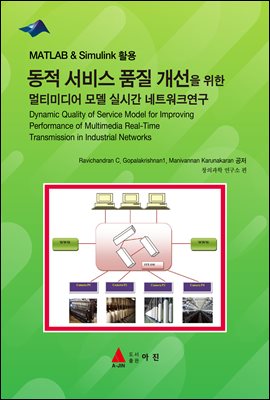
MATLAB & Simulink 활용 동적 서비스 품질 개선을 위한 멀티미디어 모델 실시간 네트워크연구
- 저자Ravichandran C. Gopalakrishnan, Manivannan Karunakaran 저
- 출판사아진
- 출판일2020-07-14
- 등록일2020-12-21
- SNS공유


- 파일포맷PDF
- 파일크기8MB
- 공급사YES24
-
지원기기
PC
PHONE
TABLET
프로그램 수동설치
전자책 프로그램 수동설치 안내
아이폰, 아이패드, 안드로이드폰, 태블릿,
보유 1, 대출 0,
예약 0, 누적대출 9, 누적예약 0
책소개
Nowadays, quality of service (QoS) is very popular in various research areas likedistributed systems, multimedia real-time applications and networking. The
requirements of these systems are to satisfy reliability, uptime, security constraints
and throughput as well as application specific requirements. The real-time
multimedia applications are commonly distributed over the network and meet
various time constraints across networks without creating any intervention over
control flows. In particular, video compressors make variable bit-rate streams that
mismatch the constant-bit-rate channels typically provided by classical real-time
protocols, severely reducing the efficiency of network utilization. Thus, it is
necessary to enlarge the communication bandwidth to transfer the compressed
multimedia streams using Flexible Time Triggered- Enhanced Switched Ethernet
(FTT-ESE) protocol. FTT-ESE provides automation to calculate the compression
level and change the bandwidth of the stream. This paper focuses on low-latency
multimedia transmission over Ethernet with dynamic quality-of-service (QoS)
management. This proposed framework deals with a dynamic QoS for multimedia
transmission over Ethernet with FTT-ESE protocol. This paper also presents
distinct QoS metrics based both on the image quality and network features. Some
experiments with recorded and live video streams show the advantages of the
proposed framework. To validate the solution we have designed and implemented a
simulator based on the Matlab/Simulink, which is a tool to evaluate different
network architecture using Simulink blocks.
목차
제 1편 : SIMULINK 기본편1.1 SIMULINK의 시작 1
블록의 연결 5
블록 파라미터의 설정 7
시뮬레이션 파라미터 (Configuration Parameters)의 설정 8
시뮬레이션의 수행 9
블록 파라미터의 표시 9
복수 데이터의 표시 11
2.2 동적 시뮬레이션 13
이차 미분방정식 17
선형 상태변수 모델 23
DC 모터의 시뮬레이션 24
함수 블록의 사용 29
차분방정식(difference equation)의 모델링 34
Subsystem(부시스템)의 구성 37
제 2편 : 연구논문
Dynamic Quality of Service Model for Improving Performance of
Multimedia Real-Time Transmission in Industrial Networks
1. Introduction 41
2. Related Works 42
3. System Model 45
4. Results and Discussions 52
5. Conclusions 53
6. References 54

















